3 Promoting Efforts to Address Global Issues and Human Security
As globalization advances, the international community has been confronted with various challenges such as disparity and poverty, terrorism, refugees and displaced persons, infectious diseases, disaster risk reduction, climate change, and marine plastic litter. These social, economic, and environmental issues are intertwined with one another, and are linked across national boundaries. In order to resolve such transboundary global issues, it is necessary for the international community to move beyond the conventional concept of developed and developing countries, and to work together to address the issues.
The Sustainable Development Goals (SDGs) are 17 international targets to be achieved by 2030, which were agreed upon by all UN Member States at the UN Summit held in September 2015 as a successor of the Millennium Development Goals (MDGs). While the MDGs were targets established for developing countries, the SDGs represent a commitment by the entire international community including developed countries, and therefore could be described as a “compass” providing the direction toward the fundamental resolution of global issues that must be tackled by both developing and developed countries.
Since the adoption of the SDGs, the Government of Japan established the SDGs Promotion Headquarters, with Prime Minister Abe as its head and all the Cabinet members as its members, and has actively worked on achieving the SDGs both in Japan and abroad through the formulation of the SDGs Implementation Guiding Principles, which sets the direction for the promotion of the SDGs, and the SDGs Action Plan, which compiles specific policies. This section features Japan’s initiatives aimed at achieving the SDGs, from the perspective of various fields including health, water and sanitation, education, gender, environment, and climate change (see also “SDG Summit 2019” for details on initiatives in 2019).
Human Security
The SDGs present a vision of a rich and vibrant society where “no one will be left behind,” and which reflects the concept of “human security” that Japan has been promoting for many years. This concept focuses on each individual, and seeks to build states and communities by protecting and empowering individuals so that they can live in dignity, free from fear and want. In the Development Cooperation Charter, it is also positioned as the guiding principle that lies at the foundation of Japan’s development cooperation. In order to promote human security, the Government of Japan undertakes various efforts, both to (i) spread the concept and to (ii) put it into practice on the ground.
(i) Spreading the concept
After the unanimous adoption by the United Nations General Assembly of the resolution concerning common understanding of human security led by Japan in 2012, Japan has been continuing to spread the concept centered on the United Nations Human Security Unit. In February 2019, Japan took the opportunity of the 25th anniversary of the introduction of the concept of human security, and held the High-level Event “Human Security at 25” with the UNDP, the United Nations Human Security Unit, and related countries at the United Nations Headquarters in New York.
(ii) Putting the concept into practice on the ground
Japan spearheaded the launch of the “UN Trust Fund for Human Security” in 1999. Japan has thus far contributed approximately ¥46.8 billion in total, and supported 248 UN projects to ensure human security in 96 countries and regions.
Dr. OGATA Sadako, former President of the Japan International Cooperation Agency (JICA), passed away on October 22, 2019.
Dr. Ogata served as the United Nations High Commissioner for Refugees and President of JICA, and demonstrated distinguished leadership on the frontlines of efforts to tackle global issues such as refugees, poverty, and conflict resolution. Furthermore, she was one of the first proponents of the concept of human security and thoroughly took a field-based approach by actively visiting various sites. For many years, Dr. Ogata made significant contributions to peace, stability, and development around the world, including co-chairing the International Conference on Reconstruction Assistance to Afghanistan held in Tokyo in 2002. Japan honors Dr. Ogata’s tremendous achievements and offers its sincere condolences on her passing.
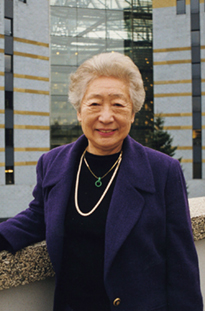
(Photo: UNHCR)
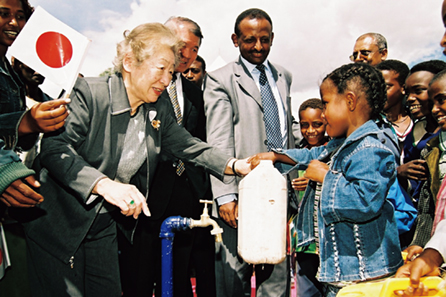
(Photo: JICA)
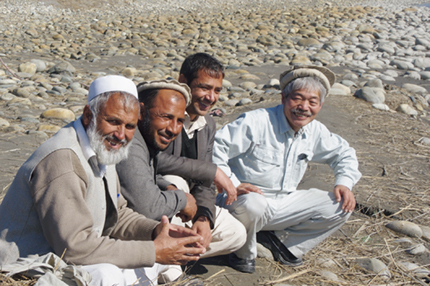
(Photo: PMS)
Dr. NAKAMURA Tetsu, Representative in Afghanistan of Peshawar-kai and Executive Director of Peace Japan Medical Services (PMS) (at the time), passed away on December 4, 2019, in eastern Afghanistan, as a victim of a gun attack.
For many years, Dr. Nakamura provided medical services to Afghan citizens and displaced persons, and strived to rehabilitate rural villages through irrigation work, thereby improving the lives of many people in Afghanistan. Furthermore, he greatly contributed to friendly relations between Japan and Afghanistan. The people’s tremendous love and respect toward Dr. Nakamura was shown by the fact that President Ghani himself carried Dr. Nakamura’s coffin at his state funeral in Afghanistan, as well as the memorial services held around the world after the incident. Japan honors Dr. Nakamura’s great achievements and offers its sincere condolences on his passing.
(1) Health and Medical Care
Many people in developing countries still do not have access to basic health services that are available in developed countries. According to the United Nations Children’s Fund (UNICEF), the WHO, and others, more than 5.3 million children (Note21) under the age of five die annually due to infectious diseases, malnutrition, diarrhea, and other preventable causes, even today. Over 295,000 women (Note22) die during and following pregnancy and childbirth per year, primarily due to the lack of emergency obstetric care provided by skilled health professionals such as obstetricians, gynecologists, and/or midwives. Furthermore, rapid population growth has made poor countries suffer from further poverty, unemployment, hunger, poor access/quality of education, and environmental deterioration. This has led to SDGs Goal 3, set as “Ensure healthy lives and promote well-being for all at all ages.” In addition, in order to respond to various health issues, which differ across countries and regions, achieving “Universal Health Coverage (UHC)” is positioned as an important international goal to ensure that all people have access to basic health services at an affordable cost when needed.
●Japan’s Efforts
Promotion of UHC (Japan’s Initiatives at International Conferences)
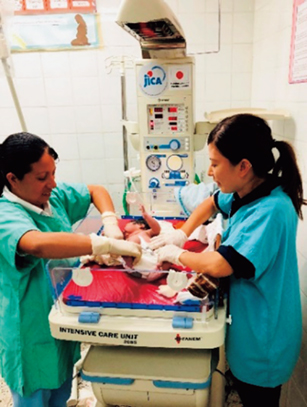
A Japan Overseas Cooperation Volunteer (JOCV) (midwife) providing technical instruction to a colleague in San Bartolomé Jocotenango, El Quiché, Guatemala (Photo: JICA)
Japan has placed importance on measures to improve healthcare that is directly linked to human security. In light of the establishment of the “Development Cooperation Charter” in February 2015, the Government of Japan established the “Basic Design for Peace and Health” as a theme-based guideline for global health policy in September the same year. This policy aims to utilize Japan’s expertise, technologies, medical devices, and services in order to achieve the following: (i) provide basic health services (UHC) for all people throughout their lifetimes, and (ii) establish a system to respond to public health emergencies such as the Ebola virus disease. These efforts are also important for the countries receiving assistance to consider and resolve health issues by themselves, while tackling challenges in global health as identified in the SDGs. The Government of Japan has been actively leading the promotion of UHC as a “Japan brand” at international meetings such as the G7, TICAD, the United Nations General Assembly, and more.
The G20 Osaka Summit and TICAD7 were held in Japan in 2019, increasing momentum for the promotion of UHC. Prior to the G20 Osaka Summit, the Government of Japan announced that it would provide contributions aimed at saving the lives of approximately one million AIDS, tuberculosis, and malaria patients, and providing immunizations to around 1.3 million children from 2019 through contributing to the field of global health (measures for various issues such as infectious diseases, health risks, maternal and child health, UHC, antimicrobial resistance (AMR) (Note23), and water and sanitation).
At the G20 Osaka Summit in June 2019, under its Presidency, Japan discussed specific policies toward resolving matters concerning achieving UHC, realizing a healthy and vibrant ageing society, and health emergencies including AMR. Japan also raised the importance of health financing for the promotion of UHC as well as the items that should be considered by finance authorities when establishing this system, and the commitment toward the “G20 Shared Understanding on the Importance of UHC Financing in Developing Countries” was confirmed at the G20 Finance Ministers and Central Bank Governors Meeting held in Fukuoka in June 2019. Moreover, during the G20 Osaka Summit, Japan held the first-ever G20 Joint Session of Finance and Health Ministers, and discussions were held on the approach to cooperation among finance authorities and health authorities, as well as cooperation between the WHO and the World Bank toward the promotion of UHC in developing countries.
The Yokohama Declaration 2019 and Yokohama Plan of Actions 2019 were adopted as outcome documents at TICAD7 in August 2019 based on the gains of TICAD VI and the G20 Osaka Summit, and the two documents reaffirmed the commitment to further promote UHC in Africa. In addition, discussions were held on effective policies, including strengthening health systems such as sustainable health financing through bolstering cooperation among health and finance authorities, strengthening capacity development, control of communicable and non-communicable diseases, maternal and child health, nutrition improvement, water and sanitation, and promoting cooperation with the private sector, thereby specifying the further promotion of UHC in Africa. Furthermore, Japan unveiled “TICAD7: Japan’s contributions for Africa,” whereby it announced its commitment to expand UHC, the Africa Health and Wellbeing Initiative, and the Tokyo Nutrition for Growth Summit 2020. At TICAD7, Japan also hosted many health-related official side events as well as the launch meeting of Gavi’s* third replenishment. Japan also held the Hideyo Noguchi Africa Prize Award Ceremony, which awarded medical care providers and researchers who made contribution to health and medical care field in Africa.
At the United Nations, the first United Nations High-Level Meeting on UHC was held in September 2019. During the meeting, Prime Minister Abe introduced various countries’ efforts to promote UHC at the G20 Osaka Summit and TICAD7 in 2019, and emphasized the importance of healthcare, as well as the promotion of horizontal efforts in the nutrition, water, and sanitation fields and strengthening health financing. At the meeting, UHC Political Declaration was endorsed, which reaffirmed goals, such as providing essential health services to all people and eliminating impoverishment due to health-related expenses by 2030. In addition, the Political Declaration demonstrated strong political-level commitments for achieving UHC, such as strengthening health financing, promoting Primary Health Care (PHC)*, tackling infectious and non-infectious diseases, improving situations on water, sanitation, and nutrition, promoting education in health, and developing human resources for health and others.
Promotion of UHC (Japan’s Specific Contributions)
In particular, under the “Basic Design for Peace and Health” enacted in 2015, the Government of Japan provides assistance that utilizes its experience, technology, and expertise, to achieve UHC that will “leave no one behind,” including the poor, children, women, persons with disabilities, the elderly, refugees and displaced persons, ethnic minorities, and indigenous people. Specifically, such support includes tangible assistance such as building hospitals, supplying medicines and medical devices, as well as non-tangible assistance such as human resources development and system building.
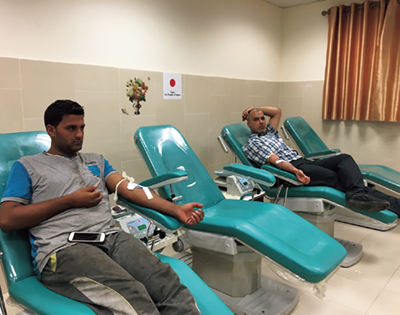
Patients taking blood tests at the hospital in the Gaza Strip in Palestine. Blood test equipment was provided through the Grant Assistance for Grass-roots Projects.
Primary healthcare services under UHC comprise all services ranging from nutritional improvement (see “(8) Food Security and Nutrition”), vaccination, maternal and child health, sexual and reproductive health, infectious disease control, non-communicable disease (NCD) control, and comprehensive community care and long-term care for the elderly. Among these, immunization is one of the most cost-effective investments, and it is estimated that 2 to 3 million lives could be saved through immunization each year.
Japan has provided a total of approximately $129.7 million to Gavi, the Vaccine Alliance, since its first contribution in 2011 until the initial budget for FY2019. Gavi was established in 2000 to improve the immunization rate in developing countries. Since its establishment, Gavi has provided immunization for 700 million children and saved more than 10 million lives. In order to promote this initiative, the Government of Japan held the launch meeting of Gavi’s third replenishment in Yokohama on the occasion of TICAD7 in August 2019, during which there were discussions regarding funding requests for the third capital increase period (2021-2025) of Gavi, the Vaccine Alliance. As for bilateral assistance, Japan contributes to increasing vaccination rates by providing assistance for vaccine production and management, as well as the maintenance and management of cold chains (Note24).
With regard to maternal and child health in developing countries, there are still significant challenges, despite improvements such as a reduction in the under-five mortality rate and maternal mortality rate, as well as an increase in births attended by skilled health professionals. Japan’s assistance aims to strengthen sustainable health systems by providing comprehensive, continuous maternal and child care and strengthening the ownership and capabilities of developing countries. In pursuit of these aims, Japan has been supporting countries such as Ghana, Senegal, and Bangladesh in an efficient manner. Through these assistance, Japan contributes to making necessary services accessible to all women at every stage of pregnancy (including that of adolescence and family planning), as well as for newborns and infants.
Furthermore, Japan is implementing activities utilizing the Maternal and Child Health (MCH) Handbook as a means of improving maternal and child health, based on its experience and expertise. The MCH Handbook can contribute to the Continuum of Care (CoC), from pregnancy, childbirth, the post-partum period (Note25), the neonatal period, infancy, and to early childhood. It also enables mothers to acquire knowledge about health, which in turn raises awareness and encourages behavior modification. To give an example of the concrete assistance, the MCH Handbook is being widely used throughout the country in Indonesia, as a result of Japan’s cooperation. Moreover, among the countries promoting the use of the MCH Handbook, including Indonesia, Thailand, the Philippines, Laos, Cambodia, and Kenya, there have been sessions to share their experiences and learn from each other. Furthermore, exchanges of opinions are being held with Afghanistan and Tajikistan, which are implementing trial use of the MCH Handbook. In addition, efforts are also being conducted for the utilization of the MCH Handbook in other countries in Africa, including Ghana.
In addition, Japan works with other development partners, such as the United Nations Population Fund (UNFPA) and the International Planned Parenthood Federation (IPPF), to promote maternal and child health that includes sexual and reproductive health services, and thereby improving the health of a greater number of women and children in aid recipient countries (see also “Stories from the Field”).
Guatemala Public nomination
Community-based Maternal and Child Health Improvement Project (Phase 1 and 2)
Grant Assistance for Japanese NGO Projects (March 2018 - (ongoing))
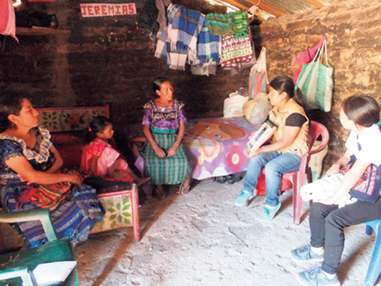
A TBA (far left) and two AMDA-MINDS personnel (seated at right) making a door-to-door visit to a pregnant woman’s home. They are providing advice on the woman’s lifestyle and danger signs during pregnancy. (Photo: AMDA-MINDS)
Among all 22 departments of Guatemala, Quiché shows the lowest rate of childbirth assisted by health-care workers, and marks the highest rate of traditional birth attendant (TBA)-led home deliveries in the country at 60.7%*. However, it is difficult to deal with heavy bleeding and risky deliveries during a home birth, and has become a cause of high rates of maternal and neonatal mortality. Therefore, AMDA-MINDS (AMDA Multisectoral and Integrated Development Services), one of Japan’s NGOs for international cooperation, started a project to improve maternal and child health in March 2018 in the city of San Bartolomé Jocotenango, a city with the highest needs in Quiché. This project is aimed at identifying risks at an early stage with prenatal care, and taking appropriate measures before falling into emergency situations.
In this project, AMDA-MINDS committed foremost to train 70 TBAs, who have earned the immense trust of communities where traditional culture is deeply rooted. This training allows the TBAs to understand the danger signs during pregnancy and childbirth and the importance of prenatal care, and to convey such knowledge to pregnant women. The training for 262 health volunteers including men was also implemented to protect expectant and nursing mothers with support from all the community members. Before the training started, women needed their husband’s permission just to undergo medical examinations. Now, since the training helped men to understand the importance of prenatal care and transporting women in danger to a hospital immediately, some women were transferred at an early-stage. AMDA-MINDS also conducts reproductive health training for elementary and junior high school students to prevent adolescent pregnancy and delivery. The training gives an opportunity for students to learn about the human body system and pregnancy, and to make their own life plans. These efforts are leading to healthier family planning and safer pregnancy and childbirth in the future.
*Source: Encuesta Nacional de Salud Materno Infantil, ENSMI 2014-2015
Strengthening Response Capacity, Prevention Measures, and Preparation for Public Health Emergencies
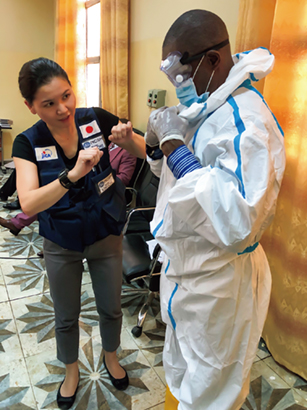
An infection control expert of the Japan Disaster Relief (JDR) Infectious Diseases Response Team providing instruction to a medical care worker on how to put on and remove protective clothing that protects against the Ebola virus in the Democratic Republic of the Congo (Photo: JICA)
In a globalized world, as infectious diseases easily spread beyond national borders and have a serious impact on the entire international community, it is important to put in place countermeasures for emerging and re-emerging infectious diseases (Note26) . The Ebola outbreak in the countries of West Africa from 2014 to 2015 took many lives and resulted in the spread of infection to neighboring countries and the secondary infection of medical personnel, and thus became a major humanitarian, economic, and political challenge for the international community. Moreover, Ebola has been spreading once again in the Democratic Republic of the Congo since August 2018. In addition to financial assistance, Japan has seamlessly provided a variety of assistance to such affected countries and international organizations, including the dispatch of experts and provision of emergency relief goods. Furthermore, Japan is supporting the efforts to overcome the Ebola crisis through public-private cooperation, such as providing medicine and rapid test kits utilizing the technology of Japanese private companies.
From the point of view that building a sustainable and resilient health system is crucial to controlling infectious diseases, Japan has been strengthening the capacity of prevention, preparedness, and response to public health crises, particularly in African countries, and aims to realize an Africa in which all people have access to health services. To that end, Japan is swiftly implementing assistance that contributes to their social and economic recovery, including assistance for the health sector such as capacity building of medical staff and improvement of medical facilities, infrastructure development, and food security enhancement.
Moreover, Japan, as a nation that proactively contributes to the peace and prosperity of the international community, has led discussions in international fora such as the G7 and TICAD on the establishment of the Global Health Architecture, a framework of the international community for responding to these health crises. In particular, on the occasion of the G7 Ise-Shima Summit in 2016, Prime Minister Abe announced a contribution of $50 million to support the strengthening of WHO’s responses to public health emergencies, of which Japan contributed $25 million by the end of the same year to the WHO Health Emergencies Programme*, and approximately $10.8 million to the Contingency Fund for Emergencies (CFE)*. Furthermore, Japan then contributed around $3 million to the WHO Health Emergency Programme in 2018, and $22 million to the CFE in 2019. These contributions to the WHO Health Emergency Programme and CFE are being used to respond to the outbreak of the Ebola virus disease in the Democratic Republic of the Congo that has continued since 2018.
In addition, with the support from the Government of Japan, the World Bank took the opportunity of the G7 Ise-Shima Summit to launch the Pandemic Emergency Financing Facility (PEF)*, and Japan announced a contribution of $50 million for the PEF before any other country. In response to the continuing Ebola outbreak in the Democratic Republic of the Congo, PEF is contributing $60 million to the crisis response efforts. Japan also led the establishment of the Standard Operation Procedures (SOP) for WHO to respond to emergencies in cooperation with the United Nations Office for the Coordination of Humanitarian Affairs (OCHA). Furthermore, Japan newly established the Japan Disaster Relief (JDR) Infectious Diseases Response Team in 2015, which was dispatched to the Democratic Republic of the Congo to provide assistance for the Ebola epidemic in 2018 and 2019. Through these efforts, Japan has been providing swift and effective assistance in infectious disease affected countries.
Responding to Antimicrobial Resistance (AMR)
Antimicrobial resistance (AMR)(Note27) is a serious threat to public health, and in recent years, more and more countermeasures against AMR have been taken. In order to advance AMR measures, Japan is promoting the “One Health Approach” for those who are engaged in the field of sanitation concerning people, animals, and the environment to work together on efforts. At the High-level Meeting on Antimicrobial Resistance in the United Nations General Assembly held in September 2016, the “Political Declaration of the high-level meeting of the General Assembly on antimicrobial resistance” was adopted. The declaration required each country and the related United Nations institutions to promote countermeasures, and the Secretary General of the United Nations to establish cross-sectoral working groups. Accordingly, the Tokyo AMR One Health Conference was held in November 2017. Moreover, in the G20 Osaka Leaders’ Declaration in 2019, it was agreed to accelerate efforts based on the “One Health Approach.” At the G20 Health Ministers’ Meeting held in Okayama in October 2019, the Ministers adopted the Okayama Declaration of the G20 Health Ministers, which mentions the importance of continuing AMR measures based on the same approach. In addition, in the same month, Japan announced that it would contribute ¥1 billion to the Global Antibiotic Research & Development Partnership (GARDP), which promotes research and development and diagnosis development for new antibiotics, and indicated that it would exert leadership for AMR measures.
Mozambique
Emergency Grant Aid for Three Countries in Southern Africa affected by Cyclone Idai
(April 2019 - October 2019)
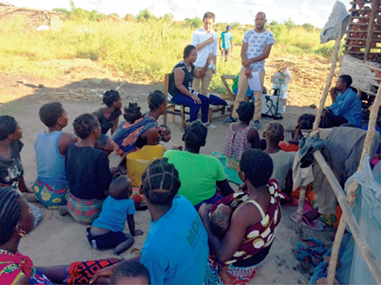
Teaching Cholera outbreak countermeasures to residents in the affected areas (Photo: UNICEF Mozambique)
On March 14, 2019, one of the largest cyclones in history hit the central part of Mozambique, which caused the loss of more than 600 precious lives. In the immediate aftermath of the disaster, damage caused by river flooding and lightning strikes received attention, but afterwards, a large-scale outbreak of cholera occurred in evacuation centers, causing a secondary disaster that made people suffer in the disaster areas.
Cholera is a disease that spreads including through water contaminated by Vibrio cholerae. The spread of cholera can be prevented by improving the water and sanitation environment in the affected areas.
Japan decided to provide $9.85 million to Mozambique in response to the damage caused by the cyclone, out of which $1.7 million was allocated to UNICEF.
In April, UNICEF Mozambique organized a cholera rapid response team that implemented a strategy to provide water and sanitation measures, including the distribution of water purification agents and a sanitation awareness campaign, to the cholera patients’ households and neighboring residents living inside a radius of 50 meters within 48 hours of patients being transported to the cholera treatment center. These measures were based on data stating that the risk of infection is 36 times higher within 50 meters of a cholera patient’s household, and had seen prior success in Haiti and Zimbabwe. At this time, Mr. MORITA Tomohiko, a Japanese official working at UNICEF Mozambique, was also one of the members of the cholera rapid response team. He also worked with the provincial governments, as well as the U.S. Centers for Disease Control and Prevention (CDC), which was actively working in those areas, to contribute to contain the spread of cholera in disaster areas.
The Three Major Infectious Diseases (HIV/AIDS, Tuberculosis, and Malaria)
SDGs target 3.3 sets out the goal of ending the epidemics of the three major infectious diseases by 2030. Japan has been providing support toward achieving this goal through the “Global Fund to Fight AIDS, Tuberculosis and Malaria (the Global Fund),” an organization whose establishment was agreed upon at the G8 Kyushu-Okinawa Summit held in 2000. Since its establishment in 2002 to the end of July 2019, Japan has contributed approximately $3.4 billion to the Global Fund. Furthermore, Japan provides supplemental bilateral aid to the developing countries receiving support from the Global Fund, in order to ensure that measures against these three major infectious diseases are implemented effectively in those countries. Japan also strives to strengthen mutual cooperation on enhancing health systems, community empowerment, and policies for maternal and child health in those countries.
As bilateral assistance for HIV/AIDS countermeasures, Japan is providing assistance such as spreading knowledge to prevent new infections and promoting awareness raising, testing, and counseling. In particular in Africa, JICA Overseas Cooperation Volunteers (JOCVs) for Infectious Disease and HIV/AIDS Control are vigorously engaged in activities including spreading the knowledge and understanding of prevention among as many people as possible, and providing care and support for people affected by HIV/AIDS.
With regard to tuberculosis, in 2008, MOFA and the Ministry of Health, Labour and Welfare (MHLW), in cooperation with JICA, the Japan Anti-Tuberculosis Association, and the Stop TB Partnership Japan, announced the “Stop TB Japan Action Plan” and have contributed to reducing the annual number of deaths from tuberculosis in developing countries, particularly in Asia and Africa. These efforts aim to achieve a 10% reduction of the number of deaths from tuberculosis worldwide (160,000 people, based on 2006 figures) by making use of Japan’s own experience and technology to take measures against tuberculosis through a public-private partnership. In 2014, the Action Plan was revised based on the Global Strategy and Targets for Tuberculosis Prevention, Care and Control after 2015, a global strategy to achieve the targets by 2035, which was adopted by WHO in 2014. This reaffirmed that Japan will continue to work on measures against tuberculosis on a global level.
In addition to these efforts, with regard to malaria, a major cause of infant mortality, Japan provides assistance for anti-malaria countermeasures such as initiatives through the strengthening of local communities, and assistance in cooperation with WHO.
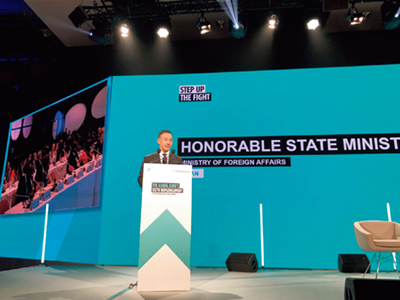
State Minister for Foreign Affairs SUZUKI Keisuke attending the Global Fund Sixth Replenishment Conference held by the Government of France (October 2019)
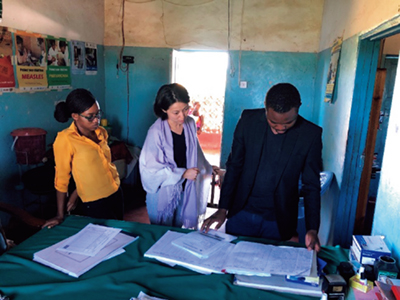
A local personnel checking whether the date of delivery, amount, inspection results, and other details are accurately recorded for tuberculosis specimens, under the guidance of a JICA expert as part of the technical cooperation project, “Project for Strengthening Basic Health Care Services Management for Universal Health Coverage in Zambia” (Photo: JICA)
Polio
Although polio is on the brink of being eradicated, Japan has been working mainly in cooperation with UNICEF to provide support for its complete eradication with a focus on three countries where cases of infection are still being identified (countries where wild strains of polio are constantly present)—Nigeria, Afghanistan and Pakistan. In particular, Japan provided an assistance of ¥1.58 billion to Nigeria in April 2019. Through this assistance, it is expected that strengthening responses to infectious diseases and the surveillance capacity system will promote social development centered on urban areas in Nigeria and contribute to preventing and controlling the spread of infectious diseases in neighboring countries. Japan also contributed ¥485 million to provide polio vaccines for approximately 20 million children under the age of five in Pakistan in December 2019. In addition, Japan has been providing assistance to Afghanistan in cooperation with UNICEF since 2002, and has recently contributed ¥755 million in FY2019. Furthermore, in Pakistan, Japan has provided grant aid amounting to a cumulative total of more than ¥11 billion in coordination with UNICEF since 1996, and provided an ODA loan of around ¥6.3 billion in 2016. Under this yen loan, a new approach (loan conversion) was adopted; in the new approach, the private sector Gates Foundation will pay the debt owed by the Government of Pakistan if certain targets are achieved. It is expected that these projects will reduce the number of new polio cases and lead to the eradication of polio in Afghanistan and Pakistan.
Neglected Tropical Diseases (NTDs)
Parasitic and bacterial infections such as Chagas disease, Filariasis, and Schistosomiasis, are known as “Neglected Tropical Diseases (NTDs),” and have infected more than 1 billion people worldwide, causing major socio-economic losses to developing countries. Since infectious diseases can have an impact beyond national borders, the international community must work as one to combat them. Thus, Japan also cooperates closely with all the relevant countries and international organizations on countermeasures against NTDs.
Since 1991, Japan has engaged in launching a full-scale effort against Chagas disease, which is also known as a “disease of poverty,” in Central American countries, and contributed to reducing the risk of infection by providing assistance to establish a system for dealing with Chagas disease vectors. Also in 1998, Japan launched the “Hashimoto Initiative,” and has since contributed to global parasitic control efforts. With regards to Filariasis, Japan also supplies educational and awareness-raising materials to provide knowledge and understanding to a larger number of people, in addition to antiparasitic agents. Moreover, Japan conducts preventive education through the dispatch of JOCVs in order to reduce the number of new cases and prevent the spread of diseases. Through these efforts, Japan will continue to contribute to the treatment for people suffering from NTDs that are not being addressed in Africa and other regions.
- *Gavi, the Vaccine Alliance
- Gavi, the Vaccine Alliance is a public-private partnership, which was established with the aim of saving children’s lives and protecting people’s health by improving immunization rates in developing countries. Governments of donor countries and developing countries, relevant international organizations, the pharmaceutical industry, private foundations, and civil society participate in this partnership.
- *Primary Health Care (PHC)
- An approach to comprehensively and equally resolve issues by residents of a local community on their own, as the primary stakeholders through responding to the most vital needs of people, in order to achieve health for all people, by recognizing health as a basic human right. It is composed of three components: (i) comprehensive and equal health and medical services that meet the requirements of people regarding health, (ii) systematic approaches to decisive factors of health, and (iii) giving individuals, families, and communities the right to make their own decisions about their health.
- *WHO Health Emergency Programme
- The WHO Health Emergency Programme is a part of the WHO that responds to health emergencies. It evaluates the health emergency response capacity of countries, supports drafting of plans, and monitors new and ongoing health emergency situations. It also provides health services to save lives in countries where health emergencies are occurring.
- *Contingency Fund for Emergencies (CFE)
- An emergency fund for responding to outbreaks and states of emergency established by the WHO in 2015 based on its reflection concerning the Ebola virus outbreak in West Africa in 2014. Decision-making regarding contributions is entrusted to the head of the WHO Secretariat, and it is possible to provide funding within 24 hours of the decision being made.
- *Pandemic Emergency Financing Facility (PEF)
- A framework for mobilizing funds quickly and efficiently when a pandemic occurs. At the outbreak of a pandemic, and when the conditions agreed in advance are satisfied, funds are instantly distributed to developing countries, international organizations, NGOs, and others through the PEF, and allocated to the budget for the emergency response.
- Note 21: As of 2018. The previous total was over 5.4 million children.
- Note 22: As of 2017. The previous total was over 303,000 women.
- Note 23: Micro-organisms such as pathogenic bacteria and viruses having resistance to antimicrobial agents such as antibacterial and antiviral agents, rendering these agents ineffective.
- Note 24: A system for delivering products to the destination while keeping them cool. This makes it possible to maintain the quality of medical supplies such as vaccines.
- Note 25: The period after childbirth in which the woman recovers to a similar condition before pregnancy, usually around one to two months after birth.
- Note 26: Emerging diseases are infectious diseases that were not previously known and have been newly recognized in recent years, such as SARS (Severe Acute Respiratory Syndrome), avian influenza, and the Ebola virus disease. Reemerging diseases are infectious diseases that had spread throughout the world in the past and subsequently saw a decrease in the number of cases, but have been on an increasing trend again in recent years, such as cholera and tuberculosis.
- Note 27: See Note 21.
